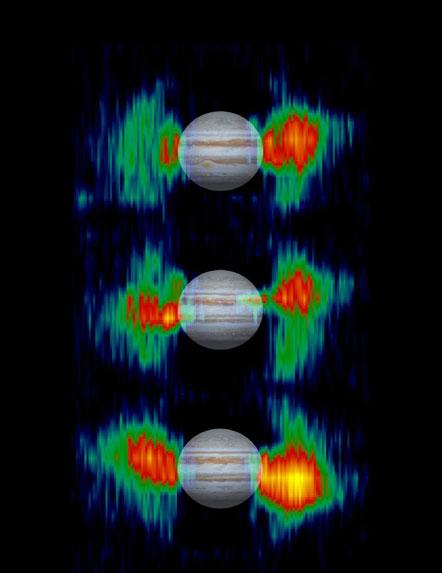Inner Radiation Belts

| PIA Number | PIA03478 |
|---|---|
| Language |
|
Download the free
Inner Radiation Belts of Jupiter
February 27, 2002
Details in radiation belts close to Jupiter are mapped from measurements that NASA's Cassini spacecraft made of radio emission from high-energy electrons moving at nearly the speed of light within the belts.
The three views show the belts at different points in Jupiter's 10-hour rotation. A picture of Jupiter is superimposed to show the size of the belts relative to the planet. Cassini's radar instrument, operating in a listen-only mode, measured the strength of microwave radio emissions at a frequency of 13.8 gigahertz (13.8 billion cycles per second or 2.2 centimeter wavelength). The results indicate the region near Jupiter is one of the harshest radiation environments in the solar system.
From Earth-based radio telescopes, the telltale radio emissions would be swamped out by heat-generated radio emissions from Jupiter's atmosphere, but Cassini was close enough to Jupiter in January 2001 to differentiate between the emissions from the radiation belts and those from the atmosphere.
The belts appear to wobble as the planet turns because they are controlled by Jupiter's magnetic field, which is tilted in relation to the planet's poles.
For more information about the Saturn-bound Cassini spacecraft and its observations of Jupiter, see the Cassini home page, http://saturn.jpl.nasa.gov.
Cassini is a cooperative project of NASA, the European Space Agency and the Italian Space Agency. The Jet Propulsion Laboratory, a division of the California Institute of Technology in Pasadena, manages the Cassini mission for NASA's Office of Space Science, Washington, D.C.
Credit: NASA/JPL
More information about the Cassini and Galileo joint observations of the
Jupiter system is available online at:
Cassini is a cooperative project of NASA, the European Space Agency and
the Italian Space Agency. The Jet Propulsion Laboratory, a division of the
California Institute of Technology in Pasadena, manages the Galileo and
Cassini missions for NASA's Office of Space Science, Washington, D.C.
